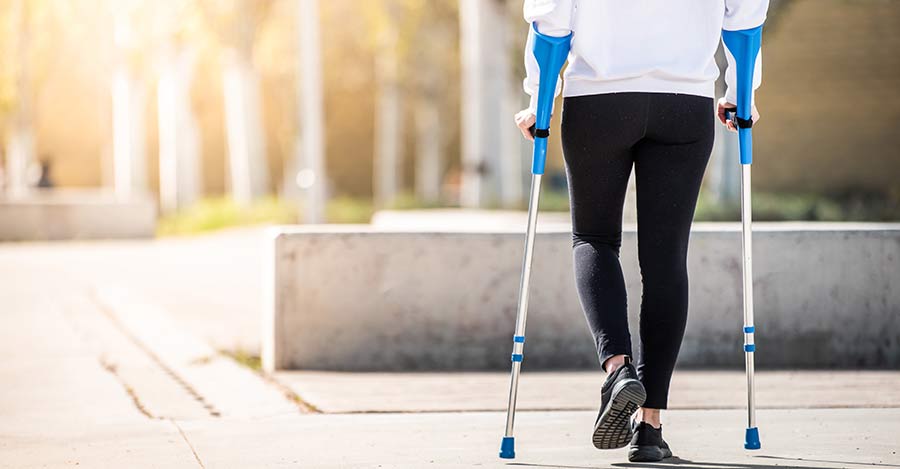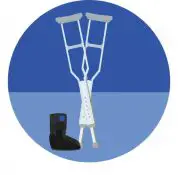When to use a Cane instead of Crutches
- Last Update:
The continuous development in the medical field provides various solutions to various cases. Mobility-aid devices are destined to offer a helping hand. They help patients deal with an injury or a disability that limits movement. These injuries differ and thus the required mobility-aid depends on your injury.
Severe injuries along the waist down may restrain you to using crutches. In some other cases, a cane is more suitable. Understanding your injury is important for you to know which one you should use. Here is when you should use crutches and when to use a cane.
Differences Between Crutches and Cane
Using a cane is completely different from using crutches. It is not a secret that using crutches is more demanding and difficult, while a cane is comfortable and easy. The main difference here is that crutches keep weight off your injury for proper healing. Crutches function as an extra pair of legs that you rely on instead of your injured leg.
A cane is more destined to help the person in use maintain balance. They offer more assistance for walking. Both mobility-aid devices are here to help you move more swiftly while you recover, and each has its purpose. To determine which one you should use, ask your doctor about your injury.
You may also have the option of resorting to other mobility aid devices like a wheelchair or a walker.
Top Benefits of Using Crutches

If you are suffering from a non-weight bearing injury, crutches are what you must go with. Crutches keep you from putting the slightest of weight on your injury, which promotes faster recovery. It is advised that you don’t put any pressure over your injured muscles. That’s why crutches are more ideal for non to minimum weight-bearing cases.
Crutches also keep your poster straight and at the right position, which limits back pain and bad poster. Moreover, crutches are more stable, and you won’t have to worry about slipping or falling. Once you get familiar with using crutches, it would be an easy sail from then. Make sure you choose a suitable size for height.
Top benefits of using a cane
While using a cane remains inadvisable for non weight-bearing conditions, using a cane when possible has its own pros. Utilizing a cane can be much safer and more comfortable than hanging to a pair of big crutches.
If you don’t feel much pain when you take a step, a cane offers more stability and support as you walk.
There are many situations where you find using a cane much better. It’s easier to get around with a cane, and no risk of ankle pain which results from misuse of crutches. Climbing up and down stairs with a cane is also a piece of cake. With one hand on the handrail and one hand on the cane, it’s safer and more comfortable. In addition, it doesn’t take much space and can be stored wherever you want.
When to use a Cane and When to Not

Using a cane is definitely much easier and offers no difficulties. However, make no mistake and be careful before you decide to use a cane. You have to understand your injury or disability very well before resorting to a cane.
Canes’ main purpose is to aid with basic mobility and give a slight relief for your pain when you step. They help you keep balance and assist you as you walk. They are generally used by the elderly to help them stay balanced and move much safely. Likewise, they can be used by individuals suffering from a chronic illness as well, like arthritis.
With that being said, some cases don’t permit the use of a cane and require crutches. In case of a non weight-bearing situation, you must not attempt to use a cane. Broken bones along your leg or foot need serious attention and must take proper recovery. Under severe circumstances, crutches or any other weight support mobility-aid device is more suitable. Be sure to follow your doctor’s advice and know when your injury can take to bear pressure. You may be able to switch to a cane once your leg or foot heal enough to bear your body weight.
Using Your Cane Instead of Crutches
Using a cane is very simple and straightforward. Hardly anything could go wrong while using a cane. However, there are a few things you might want to keep in mind. Like any other mobility aid device, it will take some time to get used to it.
First, make sure you buy a cane that is suitable for your body height and offers a comfortable handle. Keep in mind that canes aim to assist you as you walk and keep you balanced. You are not going to lean on your cane and put your weight over it. If your injury can’t support your weight, you should still wait before you change to using a cane.
When walking, hold on the cane to the opposite direction of your injured leg. The cane should move in parallel with your injured leg. Swing the cane at the same time you take a step. It should hit the ground as soon as your foot does. Every time you take a step with your injured leg, your cane is there to offer support. Canes are also very helpful when taking stairs, especially if there is a handrail.
Final Word
Choosing which mobility aid device is more suitable for injury depends on the type of injury you are dealing with. You have to note that while both crutch and canes are destined to help with movement, both have different purposes. If you are old and need some assistance with walking, canes are more suitable.
While in other cases, you have to consider your injury or disability. Your doctor will recommend using crutches if your injury can’t take any pressure, and you must wait until it heals. It is important that you don’t attempt to use a cane before due time to avoid worsening your condition.
